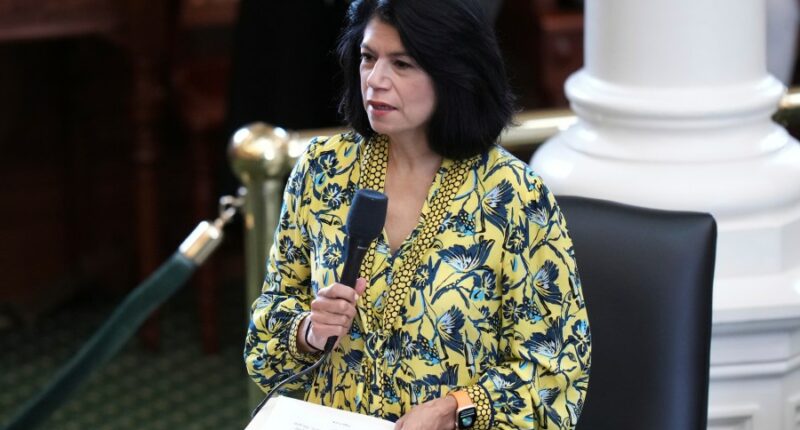Share this @internewscast.com

The Texas Senate, based in Austin, has approved a new congressional voting map that leans in favor of Republicans. This approval came early on a Saturday and awaits the signature of Governor Greg Abbott.
Former President Donald Trump has been advocating for this map, as it aims to aid the GOP in maintaining their narrow majority in Congress during the 2026 midterm elections. The map includes five new districts that are designed to benefit Republicans.
Abbott, a Republican, is expected to quickly sign it into law, though Democrats have vowed to challenge it in court.
This initiative by Trump and the Republican-dominated Texas Legislature led state Democrats to initiate a walkout lasting two weeks and triggered a series of redistricting actions nationwide.
Democrats had been ready to stage one last act of opposition, hoping to stretch the Senate vote into the early morning in an effort to postpone the approval.
State Senator Carol Alvarado, the head of the Senate Democratic caucus, took to social media to announce her plans to filibuster the bill, intending to deliver an extensive speech for several hours. However, the Senate took a prolonged dinner break just as she intended to start.
Upon their return, Alvarado was unable to proceed with her filibuster. Republicans accused her of violating Senate rules by attempting to raise funds linked to the impending filibuster.
Sen. Charles Perry said it “appears to be potentially unlawful, at least unethical, using state resources for a campaign purpose.”
A spokesperson for Alvarado did not immediately respond to an email and phone call from The Associated Press.
“Shutting down a filibuster over a fundraising email is unprecedented,” Democratic Sen. Sarah Eckhardt said in a post on social media platform X. “It exposes the hypocrisy of Republicans, who will turn around and raise millions off stealing Texans’ votes while silencing their voices.”
The weekslong showdown has roiled the Texas Legislature, marked by a Democratic walkout and threats of arrest from Republicans. Much of the drama unfolded in the House, where the map ultimately passed Wednesday.
Democrats had already delayed the bill’s passage during hours of debate, pressing Republican Sen. Phil King, the measure’s sponsor, on the proposal’s legality, with many alleging that the redrawn districts violate the Voting Rights Act by diluting voters’ influence based on race.
King vehemently denied that accusation, saying, “I had two goals in mind: That all maps would be legal and would be better for Republican congressional candidates in Texas.”
“There is extreme risk the Republican majority will be lost” in the House if the map does not pass, King said.
The showdown has also inflamed a broader, state-by-state redistricting battle, with governors from both parties pledging to redraw congressional maps.
California Democrats approved legislation Thursday calling for a special election in November for residents to vote on a redrawn congressional map designed to help Democrats win five more House seats next year. Gov. Gavin Newsom quickly signed it.
“This is not something six weeks ago that I ever imagined that I’d be doing,” Newsom said. “This is a reaction to an assault on our democracy in Texas.”
California’s map needs voter approval because, unlike in Texas, a nonpartisan commission normally draws the map to avoid the sort of political battle that is playing out.
On Friday, Abbott called California’s redistricting “a joke” and asserted that Texas’ new map is constitutional but California’s would be overturned.
Battle for the House waged via redistricting
On a national level, the partisan makeup of existing districts puts Democrats within three seats of a majority. The incumbent president’s party usually loses seats in the midterms.
The Texas redraw is already reshaping the 2026 race, with Democratic Rep. Lloyd Doggett, the dean of the state’s congressional delegation, announcing Thursday that he will not seek reelection to his Austin-based seat if the new map takes effect. Under the proposed map, Doggett’s district would overlap with that of another Democratic incumbent, Rep. Greg Casar.
The president has pushed other Republican-controlled states including Indiana and Missouri, to also revise their maps to add more winnable GOP seats. Ohio Republicans were also already scheduled to revise their maps to make them more partisan.
“Republicans are not finished in the United States,” Abbott said.
Redistricting typically occurs once a decade, immediately after a census. While some states have their own limitations, there is no national impediment to a state trying to redraw districts in the middle of the decade.
The U.S. Supreme Court has said the Constitution does not outlaw partisan gerrymandering, only using race to redraw district lines.
‘Fight fire with fire’
More Democratic-run states have commission systems like California’s or other redistricting limits than Republican ones do, leaving the GOP with a freer hand to swiftly redraw maps. New York, for example, cannot draw new maps until 2028, and even then only with voter approval.
Republicans and some Democrats championed a 2008 ballot measure that established California’s nonpartisan redistricting commission, along with a 2010 one that extended its role to drawing congressional maps.
Both sides have shown concern over what the redistricting war could lead to.
California Assemblyman James Gallagher, the Republican minority leader, said Trump was “wrong” to push for new Republican seats elsewhere. But he warned that Newsom’s approach, which the governor has dubbed “fight fire with fire,” is dangerous.
“You move forward fighting fire with fire, and what happens?” Gallagher asked. “You burn it all down.”
___
Cappelletti reported from Washington and Golden from Seattle.












